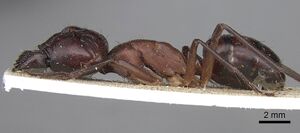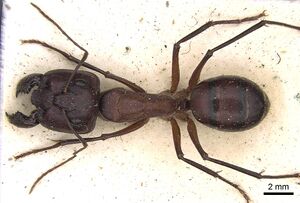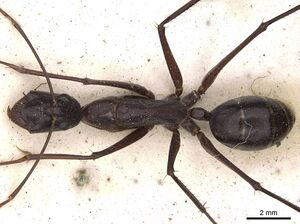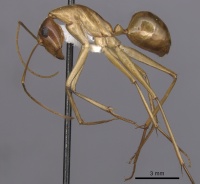Camponotus subnitidus
| Camponotus subnitidus | |
|---|---|

| |
| Scientific classification | |
| Kingdom: | Animalia |
| Phylum: | Arthropoda |
| Class: | Insecta |
| Order: | Hymenoptera |
| Family: | Formicidae |
| Subfamily: | Formicinae |
| Tribe: | Camponotini |
| Genus: | Camponotus |
| Species: | C. subnitidus |
| Binomial name | |
| Camponotus subnitidus Mayr, 1876 | |
| Subspecies | |
| |
Identification
Keys including this Species
Distribution
Latitudinal Distribution Pattern
Latitudinal Range: -10.743702° to -19.18°.
| North Temperate |
North Subtropical |
Tropical | South Subtropical |
South Temperate |
- Source: AntMaps
Distribution based on Regional Taxon Lists
Australasian Region: Australia (type locality).
Distribution based on AntMaps
Distribution based on AntWeb specimens
Check data from AntWeb
Countries Occupied
| Number of countries occupied by this species based on AntWiki Regional Taxon Lists. In general, fewer countries occupied indicates a narrower range, while more countries indicates a more widespread species. |

|
Estimated Abundance
| Relative abundance based on number of AntMaps records per species (this species within the purple bar). Fewer records (to the left) indicates a less abundant/encountered species while more records (to the right) indicates more abundant/encountered species. |

|
Biology
Castes
Images from AntWeb
   
| |
| Syntype of Camponotus subnitidus famelicus. Worker. Specimen code casent0905246. Photographer Will Ericson, uploaded by California Academy of Sciences. | Owned by MSNG, Genoa, Italy. |
   
| |
| Worker. Specimen code casent0906927. Photographer Michele Esposito, uploaded by California Academy of Sciences. | Owned by NHMUK, London, UK. |
   
| |
| Worker. Specimen code casent0906928. Photographer Michele Esposito, uploaded by California Academy of Sciences. | Owned by NHMUK, London, UK. |
   
| |
| Syntype of Camponotus subnitidus. Worker. Specimen code casent0910100. Photographer Will Ericson, uploaded by California Academy of Sciences. | Owned by MHNG, Geneva, Switzerland. |
Nomenclature
The following information is derived from Barry Bolton's Online Catalogue of the Ants of the World.
- subnitidus. Camponotus subnitidus Mayr, 1876: 65 (s.w.) AUSTRALIA (Queensland).
- Type-material: syntype major and minor workers (numbers not stated).
- Type-locality: Australia: Queensland, Peak Downs (no collector’s name).
- Type-depository: NHMW.
- Combination in C. (Dinomyrmex): Forel, 1914a: 268;
- combination in C. (Tanaemyrmex): Emery, 1925b: 91.
- Status as species: Emery, 1887a: 213; Dalla Torre, 1893: 254; Emery, 1896d: 370 (in list); Forel, 1902h: 494; Wheeler, W.M. 1915g: 817; Emery, 1925b: 91; Taylor & Brown, 1985: 120; Taylor, 1987a: 15; Bolton, 1995b: 125; McArthur, 2007a: 326; McArthur, 2014: 76.
- Distribution: Australia.
- Current subspecies: nominal plus famelicus, longinodis.
Type Material
- Holotype, many workers, Peak Downs, Queensland, Australia, Naturhistorisches Museum Wien, Vienna.
Unless otherwise noted the text for the remainder of this section is reported from the publication that includes the original description.
Description
Worker. 12-17 mm long. Black dusky with funicles and with part of the tarsus rufo-ferruginous and in the minor worker with the apex of the mandibles more or less rufo-ferruginous and in the minor with a thorax rarely testaceous and petiole and the feet less testaceous; scarcely hairy the pubescence fine and very scarce; mandibles with coarse punctations and the gaster in the same manner transversely striated, in the major worker with the head especially the anterior, sub-opaque densely and finely coriaceous with the larger punctations bearing minute erect hairs; the head in the major is very large (width 4 mm length 4.9 mm), in the posterior part arcuate and emarginate, clypeus distinctly not carined anteriorly produced emarginate and with both sides arcuate, and in the minor the head is narrow wider at the front than at the back and is clearly gradually narrowing behind the eyes towards the articulation, narrower than the thorax, clypeus distinctly keeled with the anterior margin arcuate, thorax is convex above the propodeum angle,and in the minor worker elongated, the petiole above is thickened in a knot.
References
- Emery, C. 1925d. Hymenoptera. Fam. Formicidae. Subfam. Formicinae. Genera Insectorum 183: 1-302 (page 91, Combination in C. (Tanaemyrmex))
- Forel, A. 1914a. Le genre Camponotus Mayr et les genres voisins. Rev. Suisse Zool. 22: 257-276 (page 268, Combination in C. (Dinomyrmex))
- Heterick, B.E. 2021. A guide to the ants of Western Australia. Part I: Systematics. Records of the Western Australian Museum, Supplement 86, 1-245 (doi:10.18195/issn.0313-122x.86.2021.001-245).
- Heterick, B.E. 2022. A guide to the ants of Western Australia. Part II: Distribution and biology. Records of the Western Australian Museum, supplement 86: 247-510 (doi:10.18195/issn.0313-122x.86.2022.247-510).
- Mayr, G. 1876. Die australischen Formiciden. J. Mus. Godeffroy 12: 56-115 (page 65, soldier, worker described)
References based on Global Ant Biodiversity Informatics
- Taylor R. W. 1987. A checklist of the ants of Australia, New Caledonia and New Zealand (Hymenoptera: Formicidae). CSIRO (Commonwealth Scientific and Industrial Research Organization) Division of Entomology Report 41: 1-92.

